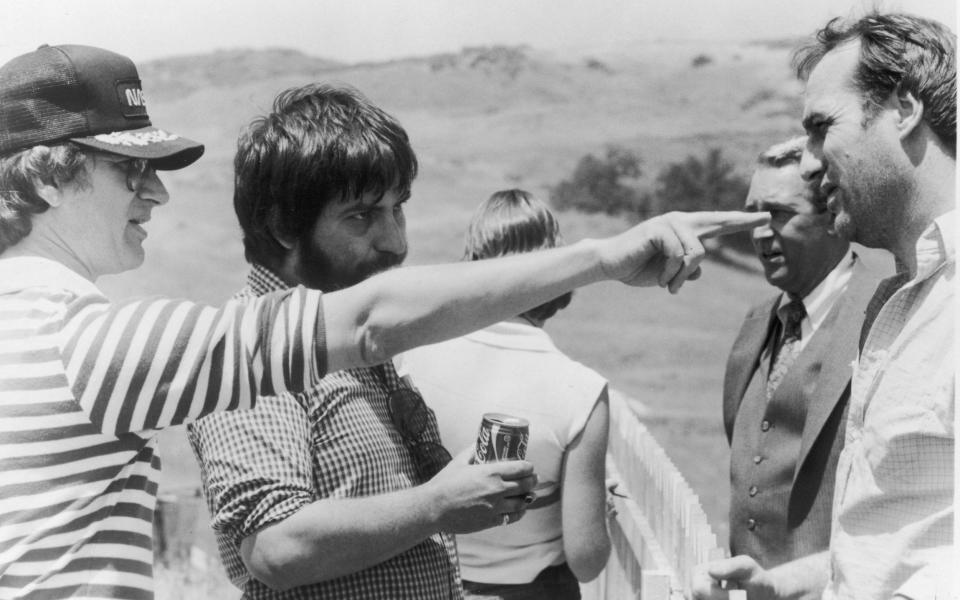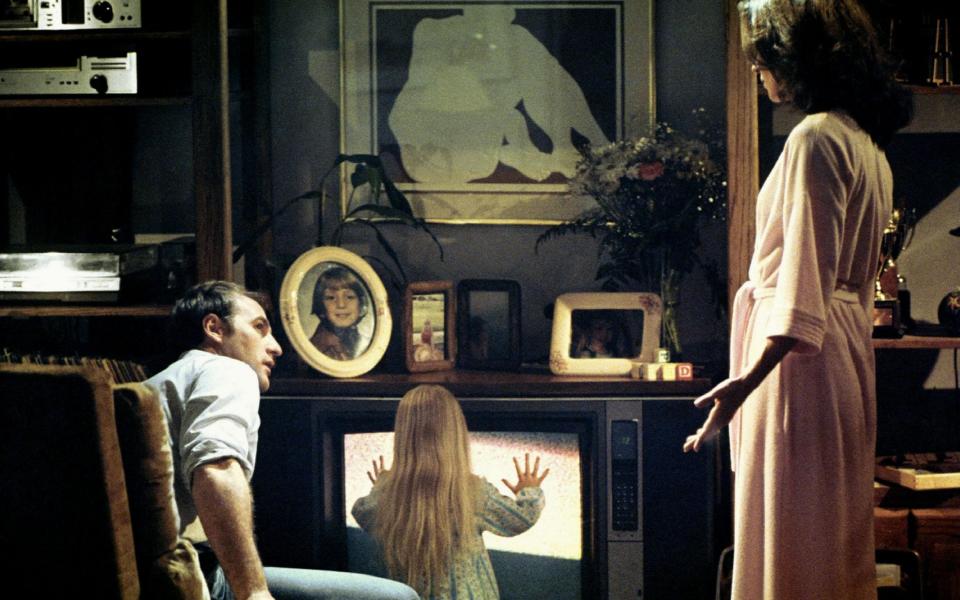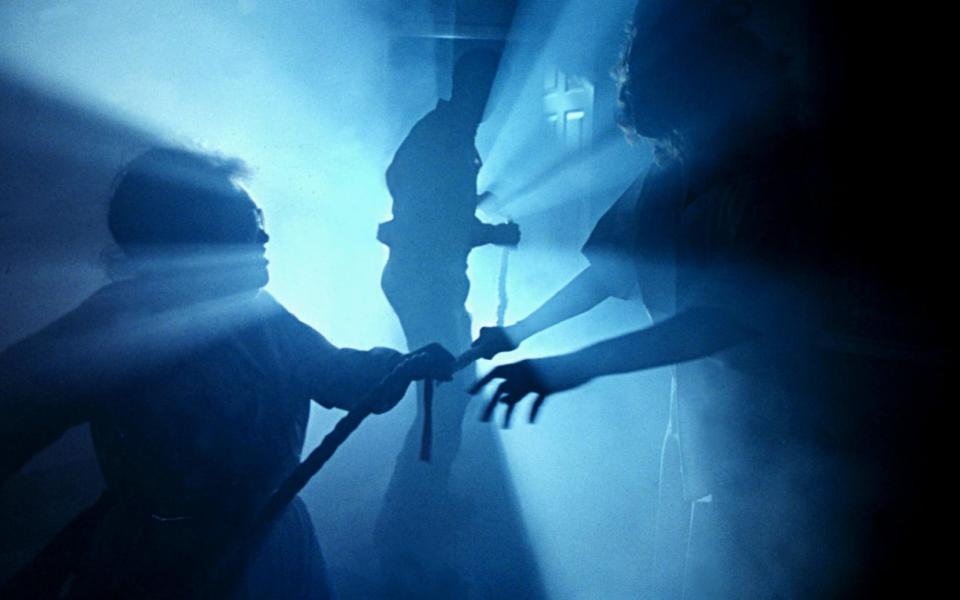The Poltergeist puzzle: who really directed it, and the truth about that ‘curse’

- Oops!Something went wrong.Please try again later.
- Oops!Something went wrong.Please try again later.
- Oops!Something went wrong.Please try again later.
- Oops!Something went wrong.Please try again later.
- Oops!Something went wrong.Please try again later.
According to Poltergeist co-writer Michael Grais, it was Steven Spielberg who came up with the idea of a haunted television set.
“Steven said he creates the poster before he creates the movie,” recalls Grais, referencing the image which sold Poltergeist in the summer of 1982: six-year-old Carol Anne (Heather O’Rourke) knelt in front of the TV, hands on the screen, communicating with an entity behind the snowy static.
For Spielberg, who co-wrote and produced Poltergeist, the idea of evil pouring straight from the television may have gone deeper than an eye-catching poster. “He kind of despised television at that time,” says Grais. “It was looked down on by movie guys!”
In the four decades since Poltergeist was first released, movies have continued to use everyday tech to haunt us: The Blair Witch Project, The Ring, Paranormal Activity, Unfriended. The latest film to do it is the superb, chilling Host, which is streaming on Shudder and takes place entirely during a Zoom call. Poltergeist brought horror into the normalcy of suburban life; Host brings it to the new normal of the Covid era.
Back in 1982, the television was more than just a cool visual and plot device in Poltergeist. The cherubic Carole Anne announces “They he-eere!” as the spirits broke the fourth wall; similarly, Poltergeist crossed over, becoming the stuff of apocryphal movie legend. TV felt like a fundamental part of the film’s power.
Though a major cinema hit (“We rented a limousine and went to the different theatres to see the lines around the block,” recalls Grais), Poltergeist was part of the VHS generation. I remember being fascinated by its presence in the video shop; I also remember the film’s reputation as a "cursed" film, whispered about at school whenever Poltergeist or its sequels were on terrestrial TV.
The big scares reach deep into childhood fears – a child-snatching tree, a clown doll that leaps out from under the bed, skeletons clambering out of the ground – and its rep heightened by the legendary “Poltergeist curse”, which internet conspiracists trace back to the production using (and angering) real skeletons as props.
The curse, so the story goes, claimed the lives of several cast members, including Dominique Dunne, killed by an ex boyfriend; and poor Heather O’Rourke, who died from a misdiagnosed intestinal condition aged just 12.
There was speculation behind the camera too: a never-ending debate about who really directed Poltergeist, actual director Tobe Hooper, or backseat director Steven Spielberg? Speaking to horror magazine Fangoria back in 1982, Hooper said he’d been working on ideas for a ghost film for several years before joining forces with Spielberg. In fact, Hooper claimed he’d had a supernatural experience days after his father died.
“Things started happening in the house that were undeniably poltergeist reactions,” he said. The drinking glasses in the kitchen exploded, and his father’s rocking chair went “berserk”.

When Spielberg called him, it was about directing the film (albeit in a much darker guise) that became ET. “I explained to him, that wasn’t really my thing but I’d always wanted to do a film about ghosts and poltergeists,” said Hooper.
Spielberg contacted screenwriting duo Michael Grais and Mark Victor about a remake of the 1943 Spencer Tracy romance, A Guy Named Joe (which Spielberg eventually directed as guardian angel weepy Always in 1989). But Grais was more interested in another project that Spielberg had brewing – something about a ghost coming out of the television.
“I called him up the next day,” says Grais. ‘I told him we weren’t excited about the other movie, but the ghost story, we’d really love to do that!’ We were new and naïve. That would never happen today.” Grais remembers being “shocked” when he heard that Hooper, best known as the director of The Texas Chain Saw Massacre, was on board as director. “Was Steven going to go in a whole other direction and make the movie really hardcore?” he laughs.
Then at the height of his powers, Spielberg’s brand of moviemaking was about fantastical forces invading wholesome suburban life, filtered through a perspective of strong family bonds and childlike wonder. See Close Encounters of the Third Kind, ET, Gremlins, and The Goonies. Writing in his Spielberg book Empire of Dreams, Andrew M. Gordon called Close Encounters, ET, and Poltergeist Spielberg’s “suburban trilogy”.

“We were going for the same tone almost as Close Encounters,” says Grais about Poltergeist. “I think we got it. It’s magical even when it’s frightening.”
Set in a newly-developed Californian suburb, Poltergeist tells the story of the Freeling family – father Steve (Craig T. Nelson), mother Diane (JoBeth Williams), and kids Dana (Dominique Dunne), Robbie (Oliver Robins), and Carol Anne (Heather O’Rourke).
After Carol Anne makes contact with something through the TV, the family is plagued by strange events: objects that move independently, the kitchen tidying itself; and an invisible force that drags people across the floor.
Things turn nasty when a spooky old tree crashes through the window to snatch Robbie and Carol Anne is sucked into a portal (via the closet). Parapsychologists come to investigate, followed by pint-sized psychic Tangina Barrons (Zelda Rubinstein), who tells the family that Carol Anne is being held by a dark entity known as “The Beast”.
Though Steve is a strapping father figure (as the voice of Mr Incredible, Craig T. Nelson looks and sounds more like his superhero alter-ego as Poltergeist and Poltergeist II roll on), the real hero is everywoman mother Diane. In fact, Steve is culpable: it's revealed that the housing developers – whom he represents as a realtor – built the community on top of a burial site.
“You sonofabitch, you left the bodies and you only moved the headstones!” he screams at his boss, after corpses emerge from the ground for a good old final scare.

Poltergeist is the dark side of Spielberg’s sense of suburbia, family, and childhood wonder. James Kendrick’s book of Spielberg, Darkness in the Bliss Out, describes how both clowns and a spindly old maple tree were among Spielberg’s own childhood fears. Grais tells me the same about his own childhood. The clown doll, he says, had to go in the movie (“I was terrified of clowns as a kid!”), while the tree sequence was based on something that really happened to him as a child, when a tree came crashing through a window during a storm.
“These things were based on our childhood fears," he says. "I guess we all have the same fears.”
The script was developed while Spielberg was also working on ET (“He was really stressed out,” says Grais. “He wasn’t sure if ET was going to be a successful movie!’). It had to be written quickly because of an impending writer’s strike. By the time production began, the strike was on. “We were picketing our own movie,” says Grais. “We were outside MGM marching around with signs.”
In 2020, Poltergeist doesn’t seem quite as scary as it once did to my ten-year-old self. It’s a rare instance of horror as a blockbuster: big special effects and set-pieces (see the manifestations of The Beast: a giant disembodied skull and later a dog-like skeleton monster) which are as Spielbergian as the suburban sensibility. “That’s what makes Steven Steven,” says Grais, “figuring out what those big set pieces are and figuring out how to put them together.”
It’s thematically and visually taut: see the dead, leafless trees watch over the suburb; the haywire TV remotes and toy cars, out of control even before the spirits arrive; and the foreshadowing of death: the family’s canary gets a nice burial in the opening minutes, before a JCB remorselessly tears the garden apart to dig the Freelings a pool.
Beneath the supernatural shenanigans there's a sly gag at the expense of the all-American family (“I don’t believe the all-American family exists,” says Grais) and the politics of its moment. The film begins with the Star Spangled Banner; later, Nelson's Steve is reading Reagan: The Man, The President. “The dark things that you bury eventually come up to haunt you," Grais says. "That’s my political view.”
It’s also a more cynical, self-aware suburbia than in Spielberg’s other movies of the time (the idyllic image of which seems as magical as any fantastical forces). When showing potential buyers around one of the identikit homes, Steve tells them: “The grass grows greener on every side.” The buyer replies: "Honey, I can't tell one house from the other."
The scares are safer than other horrors – it is rated PG, after all – but there are flashes of intensity that feel from Tobe Hooper than Spielberg: one of the paranormal investigators tears off his own face in a ghostly hallucination; the kids’ bedroom turns from swirling tornado of poltergeist activity to a literal hell-mouth, the blood-curdling sound of which briefly escapes when Diane opens the door; and – of course – the final set piece, as the skeletons of the dead rise up from below the unfinished pool.
“Tobe would want to go harder, Steven would want to go softer and they met in the middle," says Grais. "They complimented each other.”
One scene mercifully toned down was described as the “ghost rape”, when Diane is attacked in her bed. Dressed in just a t-shirt and her underwear, she is dragged up the wall and across the ceiling. “To soften the point, in order to get a PG rating, the literal rape was taken out,” Hooper told Fangoria. “Originally, you would have seen invisible fingerprints, pressing her face and body.”
The toned down version – an incredible practical effects shot in which JoBeth Williams tumbles around a life-size room rotating in the air – was the only scene Grais saw filmed. “Steven sent his assistant to get us out of the picket lines because he wanted to show us something,” Grais says. “We went into the sound stage and the whole room was on a gimbal. It was fascinating to see. Then we were back on the picket line!”

The controversy over the creative control of Poltergeist began just ahead of the film’s release, with an article in The Los Angeles Times, claiming Spielberg had taken over the project. As reported at the time, Spielberg’s ET contract with Universal prevented him from directing other films. But the article would infer that Spielberg was crediting himself.
“It derived from my imagination and my experiences, and it came out of my typewriter,” said Spielberg. He also said: “Tobe isn’t what you’d call a take-charge sort of guy. He’s just not a strong presence on a movie set.”
When Spielberg claimed he’d created all the storyboards, Hooper defended himself by asserting that he’d done half. “I thought, at the time, it was one of the best working relationships I’d ever had between a producer and director,” Hooper later told Fangoria, “and all of this was news to me.”
The ad campaign and trailer heavily emphasised Spielberg over Hooper. On the poster, Hooper was credited fourth, behind co-producers and co-writers. The Directors Guild of America investigated and fined MGM $15,000. Spielberg wrote an open letter in The Hollywood Reporter, apologising for the misconception and crediting Hooper as director.
Speculation continued over the years. Interviewed in 2007, Zelda Rubinstein said: “I can tell you that Steven directed all six days I was there. I only worked six days on the film and Steven was there. Tobe set up the shots and Steven made the adjustments. You’re not going to hear that from Tobe Hooper, you’ll hear it from Zelda, because that was my honest to god experience. I’m not a fan of Tobe Hooper.” She also accused Hooper of allowing some "unacceptable chemical agents into his work."

Speaking to horror magazine Rue Morgue in 2012, actor James Karen, who played villainous developer Mr Teague, put Rubinstein’s comments down to unhappiness in her old age. Speaking in the same article, Oliver Robins, who played Robbie, said: “The guy who sets up the shots, blocks the actors, and works with the crew to create a vision is the director. In those terms, Tobe was the director. He was the one who directed me anyway.”
In 2017, assistant cameraman John Leonetti claimed Spielberg had been the real director. Grais says he can't comment on the speculation because he was on the picket line. “We only went in for one scene," he says. "Tobe was in the director’s chair. Steven was standing behind him. It looked like they were collaborating. Everything seemed to be going smoothly.”
Poltergeist was released on June 4, 1982, just a week before ET – the “summer of Spielberg". Michael Grais and Mark Victor both wrote and produced the sequel, Poltergeist II: The Other Side, released in 1986. It’s daft (“We made some mistakes,” says Grais) but also fun and introduces the ghostly cult leader Kane, played by Julian Beck – the most unnerving monster in any of the Poltergeist movies. Poltergeist III, directed by Gary Sherman, followed in 1988. Heather O’Rourke died before its release. The story of the “curse” would persist long after.
Speaking on the Shudder series Cursed Films, Gary Sherman said he moved house to escape the relentless pestering from tabloid reporters. Craig Reardon, who did special effects on the original film, said the idea that using real skeletons has somehow created a curse is "personally offensive".
"It's an insult to the memory of a very sweet little girl, Heather O'Rourke," he said. "And it's worse than that to Dominique Dunne, who was strangled to death by her boyfriend."
He also explained that skeletons have been used as props going back to early days of horror cinema. Grais tells me they also used real skeletons for a sequence in Poltergeist II, for a scene in which the Freelings go into a cavern below their old house. He doesn't remember any spooky goings-on from the skeletons on the first film, but tells me that for the sequel, actor Will Sampson – a real-life Native American shaman – had to perform a sort-of seance.
“There was a big hill in the cavern covered in skeletons,” Grais recalls. “The first day we got to that set nobody could climb up onto that hill. Everyone keeps sliding off. Then the movie camera fell off its tripod – I’d never heard of this before. I went down and talked to Will Sampson, who was a shaman for three different tribes. I said, ‘Do you know what’s going on?’ He said, ‘Yeah, the skeletons are not happy. Leave the stage door open tonight and tell the guard to let me in. I can fix it.’ So I did and the next day, there was no problem... That's absolutely a true story.”
Poltergeist is available on iPlayer now

